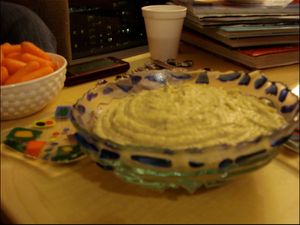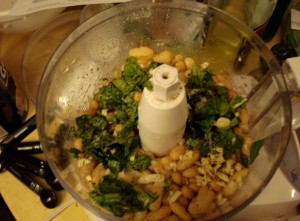By Bianca Tamburello, Dietetics Student, Sargent College
This dish was originally posted March 19, 2012, as a part of the SC Mushroom Burger with the Works.
 The cannellini spread tastes incredible and should not be left out! The beans offer a smooth hummus like texture when ground, and the lemon juice and basil add a fresh, full flavor. It also served as a great vegetable dip: while we waited for the Portobello mushrooms to broil, we ate the cannellini spread with baby carrots.
The cannellini spread tastes incredible and should not be left out! The beans offer a smooth hummus like texture when ground, and the lemon juice and basil add a fresh, full flavor. It also served as a great vegetable dip: while we waited for the Portobello mushrooms to broil, we ate the cannellini spread with baby carrots.
To make, we simply ground the cannellini beans, basil, olive oil, lemon juice, garlic, salt, and pepper in a food processor until smooth and then flavored to taste with salt and pepper.
- 1 15-ounce can cannellini beans, low sodium, drained, rinsed
- ¼ cup fresh basil leaves, packed
- 3 Tablespoons extra virgin olive oil
- 2 Tablespoons lemon juice
- 1 small clove garlic
- ½ teaspoon kosher salt
- ¼ teaspoon ground black pepper
Directions
- Place the beans, basil, olive oil, lemon juice, garlic, salt, and pepper in the bowl of a food processor and process until smooth and creamy
- Scrape down the sides of the bowl as necessary
- Season with additional salt and pepper to taste
Disclaimer: The Sargent Choice blog includes links to other websites only as information to consumers, not as medical advice. When you access an external website, keep in mind that Sargent Choice has no control over its content. Sargent Choice is not responsible for the content found at any of the sites, nor do any links imply endorsement or promotion of the company/organization, its content, services, therapeutic treatment options, or products. Accordingly, you visit any site at your own risk. Sargent Choice is also not responsible for the policies and practices of these sites, such as their Privacy Policy, use of “cookies”, etc. We encourage you to review the privacy policies of each site that you visit through a link on our website


3 Comments
distillery equipment posted on July 27, 2022 at 2:58 am
how are you
biogene posted on October 12, 2022 at 5:55 am
C. elegans UV Stress Model – UV light is present in sunlight and is also produced by electric arcs and specialized lights, such as tanning lamps, and black lights. For most terrestrial organisms, UV light (100 to 400 nm) is a common environmental toxin that must be dealt with. It is well known that exposure to UV light can lead to skin burns and fatigue.
Funda posted on April 14, 2023 at 5:17 pm
Your blog is very helpful to me. Thank you very much.